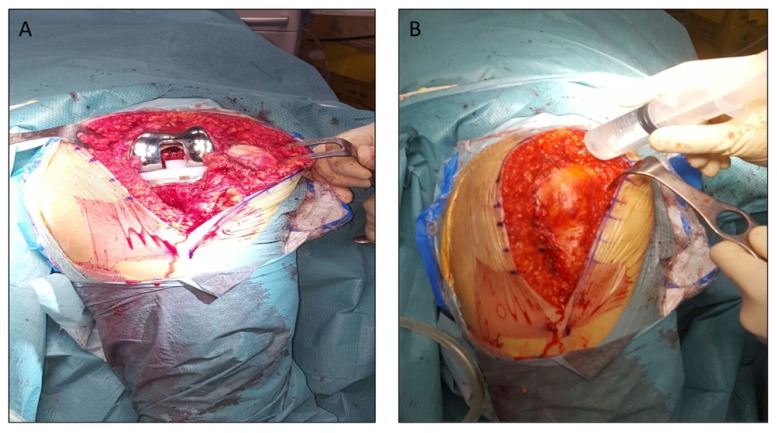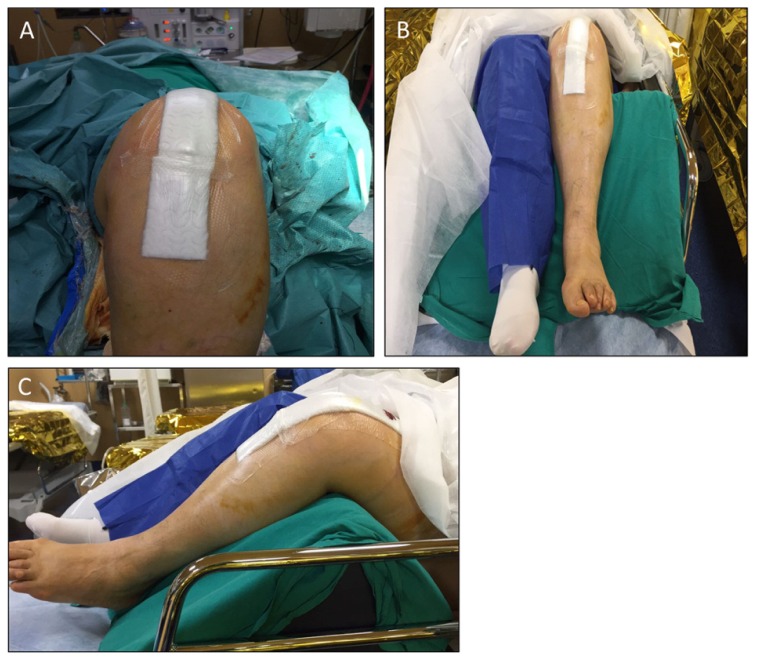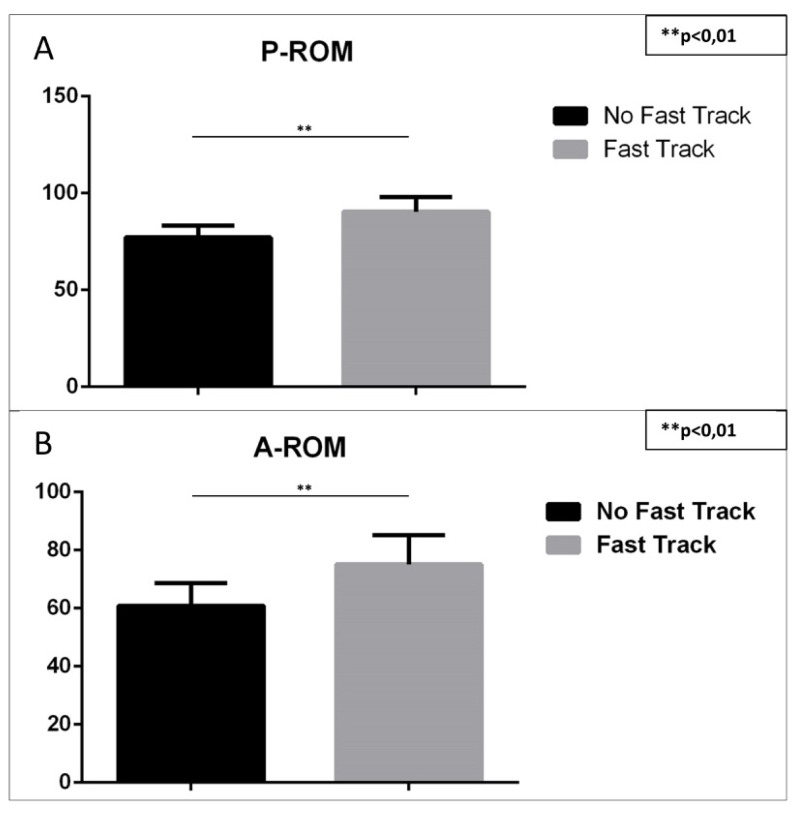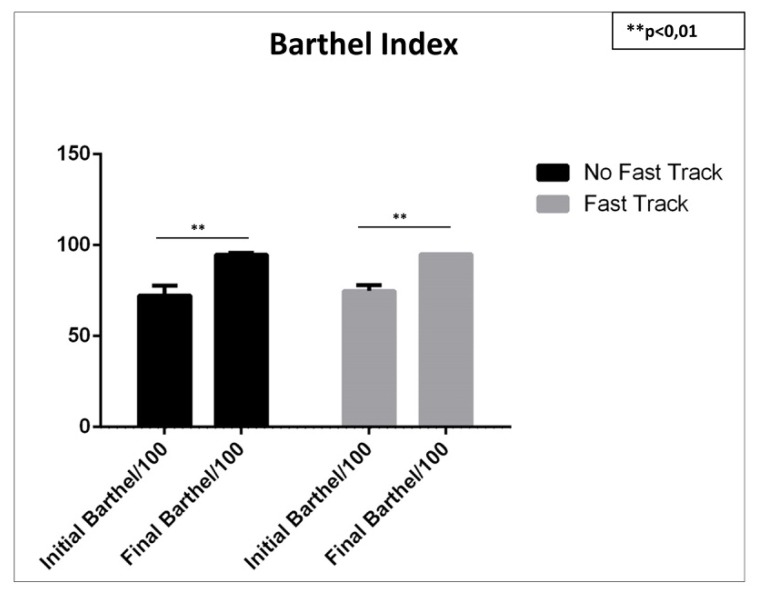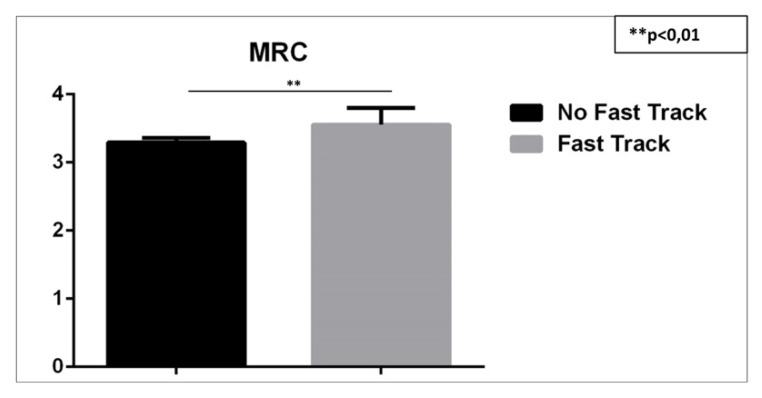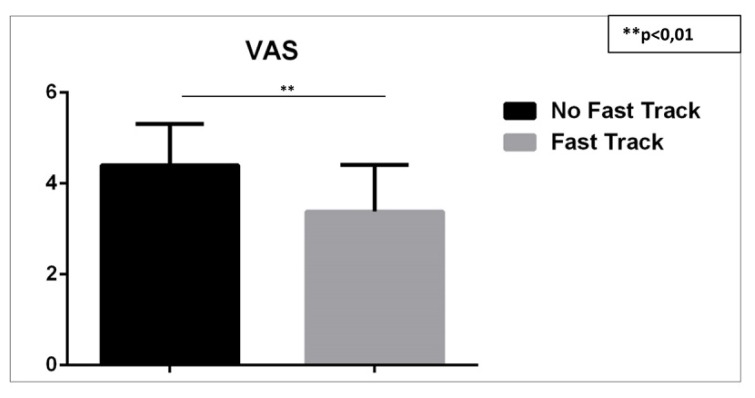Summary
Background
During the last years, programs to enhance postoperative recovery and decrease morbidity after total knee arthroplasty, have been developed across a variety of surgical procedures and referred to as “Fast-Track Surgery”. In this study we aimed to find some answers in the management of osteoarthritic patients subjected to total knee arthroplasty, by using the Fast-Track methodology. To this purpose we evaluated parameters such as early mobilization of patients, better pain management, bleeding, possible complications, reduced hospitalization time, an overall improved recovery and patient satisfaction.
Methods
132 patients were selected, of which, 95 treated with “Fast Track” method and 37 treated with traditional method (control group). All the patients were hospitalized and underwent the same rehabilitation program for the first three days after surgery.
Results
In both groups, the parameters of pain and deformity demonstrated the most rapid improvement, while those of function and movement were normalized as gradual and progressive improvement over the next 2 months. The different functional test used (Barthel, MRC, VAS) showed that the mean values were significantly greater in Fast Track group when compared to the control.
Conclusion
The results of the study confirm that the application of the Fast Track protocol in orthopaedics after total knee replacement results in rapid post-surgery recovery.
Level of evidence
IV. Case series, low-quality cohort or case-control studies.
Keywords: knee joint, total knee arthroplasty, Barthel Test, VAS score, fast track methodology, osteoarthritis
Introduction
Osteoarthritis (OA) is a degenerative disease of the articular cartilage and represents one of the most common causes of physical disability1,2. OA leads also to social, psychological and economic costs. Different OA treatments, such as surgical management, pharmacologic and non-pharmacologic treatments, are usually considered in relation to the stage of the disease1,2. In the case of mild OA, non-pharmacologic and behavioral treatments are recommended, because they are less invasive and better tolerated by patients. Instead, for advanced OA, surgery become necessary, such as arthroplasty3. Arthroplasty is an elective procedure that is done to relieve pain and restore function to the joint after damage by arthritis or some other type of trauma. It is an orthopedic surgery where the articular surface of a musculoskeletal joint is replaced3. Total knee arthroplasty (TKA) is one of the most common surgeries performed today. The reasons for the commonality of TKA are multifactorial, but are typically related to aging. An increase in the elderly population leads to an increase in articular aging, which is a reason for the exponential increase in the demand for this kind of surgery4–7. Over the past four decades, there have been many advances in the field of arthroplasty including biomechanics knowledge, surgical techniques, prosthetic design and in the materials used. During the last 15 years, programs to enhance postoperative recovery and decrease morbidity have been developed across a variety of surgical procedures and referred to as “Fast-Track Surgery” or “Enhanced Recovery After Surgery”8–10. These developments are based on procedure-specific analyses of the various components important to enhance patient recovery including preoperative optimization and information, intraoperative anesthetic and analgesic techniques, surgical techniques, postoperative pain treatment, fluid management, use of traditional care principles (drains, tubes, catheters, monitoring, etc.) and postoperative rehabilitation techniques11–13. Fast-track knee arthroplasty may provide the best available treatment by combining evidence-based clinical features with organizational optimization, resulting in reduced perioperative morbidity and mortality, shorter recovery and earlier achievement of functional milestones. These treatments lead to shorter hospital stays and potentially less readmissions compared to more conventional treatments without the same combined focus on optimization14,15. All of the above mentioned treatments, both pharmacological and non-pharmacological, used to manage OA are problematic, but solutions to these problems are on the horizon16. There has been poor information regarding the treatment of OA to help medical doctors and patients choose the best-adapted treatment to manage pain and disability limitations17. For these reasons, we aimed to find some answer in the management of osteoarthritic patients subjected to total knee arthroplasty and subsequently to the Fast-Track methodology to evaluate early mobilization of patients, better pain management, bleeding, possible complications, reduced hospitalization, an overall improved recovery and patient satisfaction.
Methods
Study design
Total knee arthroplasty (TKA) patients, operated under the same surgeon at the Polyclinic “G.B. Morgagni” Orthopedics (Traumatology and Rehabilitation Unit, Catania) between January 2014 and January 2017, were selected for this study. The criteria for inclusion involves patients >40 and <95 yrs old. All the patients were supplied with an illustrated educational book during their first visit to the clinic to help them understand the details of their operation. Exclusion criteria included previous major knee surgery of the same joint, preoperative inability to bend the knee > 90° or allergy to any of the drugs used in this study. 132 patients were included in the study, both male and female. 95 (mean age, 71,10±7,77) patients were treated with the Fast-track method and 37 (mean age, 74,62±6,42) patients were used as control group and treated with the traditional methods. In each patient, we evaluated complications such as fever, transfusion, hemoglobin, nausea and hematoma (Tab. I). This study is a retrospective observational study in agreement with the ethical guidelines of the Declaration of Helsinki. All participants gave their written informed consent according to international ethical standards18,19.
Table I.
Patients characteristics and medical complications.
| Patients characteristics and medical complications | No Fast Track | Fast Track |
|---|---|---|
| No. Patients | 37 | 95 |
| Age (mean±SD) | 74,62±6,42 | 71,10±7,77 |
| Total Hemoglobin Loss (mean±SD) | −3,58±1,88 | −3,09±1,26 |
| Transfusion (no.) | 4 | 4 |
| Hematoma (no.) | / | 31 |
| Fever (no.; mean±SD) | 25 (38,06°±0,26) | 44 (37,54°±0,38) |
| Nausea (no.) | / | 10 |
Surgery
The TKA procedure (Fig. 1A) was performed using a parapatellar medial incision of 10–12 cm without any use of a tourniquet fascia. This procedure takes an average of 40 minutes. Patients were not given pre-medication before surgery, but all subjects were given 5 ml/500 mg of tranexamic acid by intravenous injection before incision, and another phial of 5 ml/500 mg of tranexamic acid by intravenous injection before cementation. Hemostasis during surgery was very accurate to avoid bleeding afterwards and to help control swelling in the knee. The suture of the capsula was provided by Vycril 2.0. At the end of suture, before closing the skin, 4 phials of tranexamic acid plus 5 phials of chirocaine 7,5 mg/ml were injected along the borders of and into the capsula (Fig. 1B) to reduce pain after surgery and aid in early mobilization. A tourniquet was used only during cementation. No articular drainage was used. After the skin suture was applied, an advanced colloid patch (Fig. 2A) was used instead of a regular compressive flat patch (Bendage). Patients left the surgery room with the knee bent at 90° on a triangular pillow for 5 hours (Figs. 2B, C). A continuous elastomeric pumps infusion, containing betamethasone, ondansetron, ketorolac and morphine and regulated based on patient weight, were used to control post surgical pain. The patients in the control group underwent the traditional TKA surgery method, whereby, one regular articular drainage and tranexamic acid intravenous injection were used at the beginning of the surgery and during cementation.
Figure 1 A, B.
A) Total knee arthroplasty; B) Tranexamic acid and chirocaina injection through the capsula.
Figure 2 A–C.
A) Advanced colloid patch; B) Knee bent at 90 degrees on a triangular pillow, frontal view; C) Knee bent at 90 degrees on a triangular pillow, lateral view.
Rehabilitation
All the patients were hospitalized at the Traumatology and Rehabilitation Unit and underwent the same rehabilitation program for the first three days after surgery, consisting in 2 sessions a day for 30 min. After, they performed a 3 weeks follow-up rehabilitation protocol including 1 session a day for 1 hour. At the end of each session, all patients were subjected to cryotherapy for 20 minutes.
Day zero post operation (p.o., the same day of surgery), 3 hours after post operation, the patients started ankle motion and isometric quadricep contractions, postural position movements from supine to seated and from seated to standing (autonomy transfer), and walking with a walker for 10–15 minutes. Patients were placed on a continuous passive motion (CPM) machine that performs gentle passive movements to restore their range of motion (ROM). Active ROM were asked to tolerance (Fig. 3A, B).
Figure 3 A–D.
A) 6 hours post operative (post op), extended knee; B) 6 hours post op, active flexion of the knee at 40°; C) Day 3 post op: go up of the stairs; D) Day 3 post op: go down of the stairs.
Day one p.o.: patients must be able to perform the straight leg race (SLR) for quadriceps control, flexion and extension of the knee from the supine position and walking with double crutches. Patients were placed on a CPM machine.
Day two p.o.:, the same practices from day one were followed by autonomy walking for 60–70 meters with double crutches.
Day three p.o.: this period was focused on giving the correct instructions to patients regarding how to perform the activity daily life (ADL) at home without supervision and go up and down stairs (Fig. 3C, D). The discharge criteria included patients demonstrating a range of motion (ROM) of at least 0°/0°/90°, autonomy ADL, autonomy transfer and walking with double crutches at least 70 meters.
During further follow-up at three weeks, all patients underwent a one day rehabilitation program focused on increasing hip muscles, quadriceps, hamstrings, adductor muscle strength and stretching, proprioception exercises, biking and walking.
Functional Test: Range of Motion (ROM) Measurements
Knee extension ROM measurements were taken with a goniometer using a bubble level attachment, while the patient was in the supine position with both knees extended. Goniometer measurements of knee extension have been found to have an intraclass correlation coefficient (ICC) of 0.98 for intratester reliability and 0.99 for intertester reliability. The patient was instructed to actively tighten their quadriceps and fully straighten their knee to the best of their ability, and knee ROM was measured as previously described20. Independent from the treating physical therapist, knee extension measurements were taken by two designated physical therapists. Immediately after surgery and while in the hospital, the patient was asked to initiate ROM activities starting from passive ROM (P-ROM) and continuing with active ROM (A-ROM). Goals for follow visits up included symmetrical knee hyperextension to 0° and 120° of knee flexion and without extension deficit. It is important to emphasize that ROM is unlimited during the initial phase of post-operative rehabilitation. The only limit to obtaining symmetric ROM is patient tolerance. Most patients lose some of their initial ROM after they are discharged. However, the psychological effect of knowing that near full ROM was achieved immediately post-operatively is helpful in obtaining full ROM again.
Functional Test: Barthel Index
The modified Barthel Index (MBI) was used as previously described21,22. This index assesses the degree of ADL independence and includes the following 10 items: feeding, personal hygiene, bathing, dressing, toilet use, bladder control, bowel control, ambulation, transfer, and stair climbing with a maximum achievable score of 100. A score in the range of 1–24 indicates total dependence, 25–49: severe dependence, 50–74: moderate dependence, 75–90: mild dependence, 91–99: minimal dependence and a score of 100 indicates complete independence. An inter-rater reliability value of r = .95 and intrarater reliability value of r = .89 indicate high reliability. Guidelines for use of the Barthel index are as follows: the index should be used as a record of what a patient does, not as a record of what a patient could do, the need for supervision renders the patient not independent, and the use of aids to be independent is allowed.
Functional Test: Medical Research Council (MRC) Scale for Muscle Strength
MRC test muscle strength by employing manual resistance, with the patient lying on their dorsal, ventral, lateral decubitus and in a sitting position as previously described23. Both their left and right sides are tested to minimize dominance influences and possible asymmetrical involvement of the muscle groups. Shoulder flexors, extensors, abductors, adductors, internal and external rotators; elbow flexors and extensors, supinators, pronators; wrist flexors and extensors; hip flexors, extensors, abductors, adductors, internal and external rotators; knee flexors and extensors; ankle dorsiflexors, plantar flexors, invertors and eversors are evaluated. The best score obtained (comparing both sides) is registered. Muscle strength is graded from zero to five. Zero means no contraction, one indicates flicker or trace of contraction, two denotes the existence of active movement, three means active movement against gravity, four indicates active movement against gravity and manual resistance and five is used for normal strength.
Functional Test: Visual Analogue Scale for Pain (VAS)
Level of pain was also assessed through the visual analogue scale for pain (VAS pain; 0–10 mm), which was designed to assess the perceived discomfort (0: no discomfort, 10: maximum discomfort)24. All scores were assessed blindly by one physiatrist, one kinesiologist and one physical therapist during all days of the study. The tests were repeated in triplicate.
Statistical analysis
In order to maximize the information obtained from the minimum resources and to generate statistically robust data, the power analysis sample size was performed using the G*Power3.1 software (Düsseldorf University, Düsseldorf, Germany). Statistical analysis was performed using the GraphPad Prism 6.01 software (©2015 GraphPad Software, Inc., La Jolla, CA, USA). Data was analyzed by three blind investigators25. Statistical significance relating all tests performed within the groups and between the groups was assessed using the unpaired t test with Welch’s correction. P-values of less than 0.05 were considered statistically relevant, while p-values of less than 0.01 were considered statistically significant26. Results were presented as the mean±standard deviation (SD)27.
Results
Functional Test: Range of Motion (ROM) Measurements
ROM measurements were assessed using a goniometer to measure knee extension both in passive and active leg flexion, P-ROM and A-ROM, respectively. P-ROM statistical analysis between the two groups, Fast-Track and No Fast-Track, showed that the mean values were 90.42±7.49 and 77.20±6.14, respectively. The Fast-Track P-ROM was significantly greater than the No Fast-Track P-ROM (p<0.01) (Fig. 4A). Statistical analysis of the A-ROM showed an analogous result, whereby, the mean values were 75.09±10.15 and 60.84±7.83 for Fast Track and No Fast Track groups, respectively. Therefore, the Fast-Track A-ROM was significantly greater than No Fast-Track A-ROM (p<0.01) (Fig. 4B). Hence, the Fast-Track group showed a better performance as testified by P-ROM and A-ROM values.
Figure 4 A, B.
Chart of P-ROM and A-ROM: A) Statistical analysis showed that the Fast Track P-ROM was very significantly greater than the No Fast Track P-ROM (p<0.01); B) Statistical analysis showed the Fast Track A-ROM was very significantly greater than the No Fast Track A-ROM (p<0.01). The Fast Track group showed a better ROM performance of ROMs.
Functional Test: Barthel Index
The modified Barthel Index (MBI) assesses the degree of ADL independence and the maximum achievable score is 100. The score range of 1–24 indicates total dependence, 25–49 indicates severe dependence, 50–74 indicates moderate dependence, 75–90 indicates mild dependence, and 91–99 indicates minimal dependence, and a score of 100 indicates complete independence. In our retrospective study, we considered the initial Barthel Index and the final Barthel Index for every patient. In addition, we evaluated the significant differences between the Fast-Track group and the No Fast-Track group and also within the groups. Statistical analysis within the two groups showed that both in the Fast-Track group and the No Fast-Track group the difference between initial Barthel Index and the final Barthel Index was significant (p<0.01) (Fig. 5), as expected. However, statistical analysis between the two groups showed that the difference between final Barthel Index of Fast-Track and the final Barthel Index of the No Fast-Track group was not significant (p>0.05) (Fig. 5). We observed also that the Fast-Track and No Fast-Track groups had a final Barthel Index of 95.00±0.0 and 94.86±0.82, respectively. This result means that both groups achieved a high degree of ADL independence regardless of the postoperative management.
Figure 5.
Chart of the Barthel Index: the difference between initial and final Barthel Index between the two groups (Fast Track and No Fast Track) is significant (p<0.01). However, the difference between final Barthel Index for the Fast Track and the No Fast Track is not significant (p>0.05).
Functional Test: Medical Research Council (MRC) Scale for Muscle Strength
MRC tests muscle strength and is graded from zero to five. Zero means no contraction, one indicates flicker or trace of contraction, two denotes the existence of active movement, three means active movement against gravity, four indicates active movement against gravity and manual resistance and five is used for normal strength. Statistical analysis of the MRC test between the two groups, Fast-Track and No Fast-Track, showed that the mean values were 3.55±0.24 and 3.29±0.06, respectively. This result means that the difference between means values was significant (p<0.01). Both groups achieved an active movement against gravity (grade 3), while the Fast-Track group showed a better result (Fig. 6).
Figure 6.
Chart of the MRC test: The difference between the mean values of the Fast Track and the No Fast Track groups is significant (p<0.01). Both groups achieve a mean value greater than grade 3 (active movement against gravity), while the Fast Track group shows a better result.
Functional Test: Visual Analogue Scale for Pain (VAS)
VAS pain assess level of pain considering the perceived discomfort (0: no discomfort, 10: maximum discomfort). Statistical analysis of the VAS pain test for the Fast-Track and No Fast-Track group showed that the mean values were 3.38±1.02 and 4.40±0.91, respectively. This result means that the difference between means values was significant (p<0.01). Both groups didn’t achieve a high level of VAS, but the Fast-Track group showed a lower pain level compared with the No Fast-Track group (Fig. 7).
Figure 7.
Chart of the VAS pain test: The difference between the means values of the Fast Track and No Fast Track groups is significant (p<0.01). Both groups do not achieve a high level of VAS but the Fast Track group shows a lower pain level compared with the No Fast Track group.
Discussion
The intervention of total hip replacement (THR) and TKA represents one of the most frequent orthopedic surgeries performed today. European and world demand for this type of intervention is growing. Over the past four decades, there have been many advances in the field of arthroplasty, including biomechanics knowledge, surgical technique, prosthetic design and materials used28,29. The “Fast Track” protocol to the prosthetic hip and knee recovery, aims to give patients the best treatment available at each stage of the surgical route by being a dynamic entity. The “Fast Track” methodology combines elements of “evidence based medicines” with clear, practical and clinical implications with organizational optimization, determining a revision of the traditional practices obtaining a path simplified from admission until discharge and beyond29. The fundamental aim of the “Fast Track” is to reduce morbidity and convalescence through the early attainment of functional milestones. The scrupulous determination of clinical and functional criteria discharge gives reduced hospitalization and high patient satisfaction without increasing the risk of complications profile postoperative30. The results published to date on this new method shall provide important new and substantial clinical and organizational skills with a high degree of safety and patient satisfaction30–34. The earlier and more intensive physiotherapy exercise begun after TKA, may prevent the early loss of function and enhance recovery35. In the present study we report that in both groups, the parameters of pain and deformity demonstrated the most rapid improvement with excellent results, while those of function and movement were normalized as gradual and progressive improvement over the next 2 months. Statistical analysis of the P-ROM and A-ROM between the two groups, Fast-Track vs No-Fast-Track, showed that the mean values were significantly greater in Fast Track than the No Fast Track P-ROM and A-ROM (p<0.01). In both the Fast Track and No Fast Track group, the difference between the initial and final Barthel index was significant (p<0.01). MRC tests for the Fast Track and No Fast Track groups showed that the mean values were 3.55±0.24 and 3.29±0.06, respectively, and that the difference between the means values was significant (p<0.01). Statistical analysis of the VAS pain test for the Fast-Track and No Fast-Track group showed that the mean values were 3.38±1.02 and 4.40±0.91, respectively. This result means that the difference between means values was significant (p<0.01). Both groups did not achieve a high level of VAS, but the Fast-Track group showed a lower pain level compared with the No Fast-Track group. The present study confirmed the possibility of obtaining a patient’s quick recovery prosthesis through better towards coordination between multidisciplinary team medical-surgical, rehabilitative and administrative. The latter seeking a patient’s quick recovery prosthesis, which takes the path Fast Rehab a leading role of its rehabilitation through an outlet on appropriate expectations. The influence of surgical approaches on bleeding have not been extensively researched, but minimally invasive surgery has been suggested to reduce blood loss36. Several review studies have proved that the use of IV or topical tranexamic acid makes a substantial difference for blood loss37,38. The absence of drainage and reduction of transfusions will drastically reduce the post-operation complications of nosocomial nature. The results of the study confirm that the application of our Fast Track protocol in orthopaedics for total knee replacements, gives a rapid post-surgery recovery. The reduction of the recovery time comes along with a significant reduction of the pain felt by the patient, thanks to the control of the hematoma and an early mobilisation. The reduction of the comorbidities is optimised thanks to the improvement of the surgery techniques, the careful management of blood losses and the pain control by continuous elastomeric pumps infusion. The absence of drainage however leads to some complication as development of hematoma and following fever that anyway resolve in reabsorption phase. The nausea depends of continuous elastomeric pumps although presence of antiemetics as ondansetron. All these benefits improve the treatment management of the patients and increase their satisfaction. In our program the patient education is fundamental to better help patients understand the run protocol of the study39,40. They play the main role in the recovery process thanks to the knowledge of the different steps of the rehabilitation program. Some days before the surgery patients are given information about the treatment they are going to start, without the need of bed immobilisation. A daily report is also given by the rehabilitation team to the patients so that they can work on their own to improve their performances. The aspects here described can only be applied and realised thanks to a close collaboration between all the figures dealing with the patients: surgeons, rehabilitation team and nurses, as well as the clinic administrators. The novelty of this study related to the state of the art of the current literature is the new surgical used technique (drainage absence), hematoma management and pain control by elastomeric pumps to reduced hospital stay.
Conclusions
Lifestyles have changed today compared with 20 years ago and also developments in knee and hip surgery. Old people is growing worldwide and so the osteoarthritis disease. These needs are reflected by the needs of patients who desire fast recovery and no pain. We believe that the Fast-Track method can be applied by all public and private hospitals with high levels of clinic results and patient satisfaction. The latter gives the possibility to achieve a faster recovery of patient that underwent TKA, with a better coordination and collaboration between the orthopaedic surgeons, physiatrists, physical therapists and patients; decrease of bleeding and swelling, although any articular drainage has been used; reduced hospital stay and not drainage used need to be considered also important in terms of reduction of nosocomial infection. We continue to study this method improving the surgery and the rehabilitation program. In this way we can really perform better results and, probably, we can have soon more data that will help the recovery, pain and ROM of the patients.
Acknowledgements
This study was supported by the University Research Project Grant (Triennial Research Plan 2016–2018), Department of Biomedical and Biotechnological Sciences (BIOMETEC), University of Catania, Italy. The Authors would like to thank Prof. Iain Halliday for commenting and making corrections to the paper. The Authors would like to thank Prof. Iain Halliday for commenting and making corrections to the paper.
Footnotes
Conflict of interest
The Authors declare that they do not have any conflict of interest.
References
- 1.Musumeci G, Carnazza ML, Loreto C, Leonardi R, Loreto C. β-Defensin-4 (HBD-4) is expressed in chondrocytes derived from normal and osteoarthritic cartilage encapsulated in PEG-DA scaffold. Acta Histochem. 2012;114:805–812. doi: 10.1016/j.acthis.2012.02.001. [DOI] [PubMed] [Google Scholar]
- 2.Musumeci G, Carnazza ML, Leonardi R, Loreto C. Expression of β-defensin-4 in “an in vivo and ex vivo model” of human osteoarthritic knee meniscus. Knee Surg Sports Traumatol Arthrosc. 2012;20:216–222. doi: 10.1007/s00167-011-1630-x. [DOI] [PubMed] [Google Scholar]
- 3.Civinini R, Carulli C, Matassi F, Lepri AC, Sirleo L, Innocenti M. The Survival of Total Knee Arthroplasty: Current Data from Registries on Tribology: Review Article. HSS J. 2017;13:28–31. doi: 10.1007/s11420-016-9513-9. [DOI] [PMC free article] [PubMed] [Google Scholar]
- 4.Musumeci G, Loreto C, Clementi G, Fiore CE, Martinez G. An in vivo experimental study on osteopenia in diabetic rats. Acta Histochem. 2011;113:619–625. doi: 10.1016/j.acthis.2010.07.002. [DOI] [PubMed] [Google Scholar]
- 5.Musumeci G, Szychlinska MA, Mobasheri A. Age-related degeneration of articular cartilage in the pathogenesis of osteoarthritis: molecular markers of senescent chondrocytes. Histol Histopathol. 2015;30:1–12. doi: 10.14670/HH-30.1. [DOI] [PubMed] [Google Scholar]
- 6.Musumeci G, Castrogiovanni P, Trovato FM, Imbesi R, Giunta S, Szychlinska MA, Loreto C, Castorina S, Mobasheri A. Physical activity ameliorates cartilage degeneration in a rat model of aging: a study on lubricin expression. Scand J Med Sci Sports. 2015;25:e222–230. doi: 10.1111/sms.12290. [DOI] [PubMed] [Google Scholar]
- 7.Musumeci G, Castrogiovanni P, Mazzone V, Szychlinska MA, Castorina S, Loreto C. Histochemistry as a unique approach for investigating normal and osteoarthritic cartilage. Eur J Histochem. 2014 Apr 15;58(2):2371. doi: 10.4081/ejh.2014.2371. [DOI] [PMC free article] [PubMed] [Google Scholar]
- 8.Kehlet H, Dahl JB. Anaesthesia, surgery, and challenges in postoperative recovery. Lancet. 2003;362:1921–1928. doi: 10.1016/S0140-6736(03)14966-5. [DOI] [PubMed] [Google Scholar]
- 9.Kehlet H, Slim K. The future of fast-track surgery. Br J Surg. 2012;99:1025–1026. doi: 10.1002/bjs.8832. [DOI] [PubMed] [Google Scholar]
- 10.Kehlet H. Fast-track hip and knee arthroplasty. Lancet. 2013;381:1600–1602. doi: 10.1016/S0140-6736(13)61003-X. [DOI] [PubMed] [Google Scholar]
- 11.Kehlet H, Thienpont E. Fast-track knee arthroplasty - status and future challenges. Knee. 2013;20:29–33. doi: 10.1016/S0968-0160(13)70006-1. [DOI] [PubMed] [Google Scholar]
- 12.Zietek P, Zietek J, Szczypior K, Safranow K. Effect of adding one 15-minute-walk on the day of surgery to fast-track rehabilitation after total knee arthroplasty: a randomized, single-blind study. Eur J Phys Rehabil Med. 2015;51:245–252. [PubMed] [Google Scholar]
- 13.Van Egmond JC, Verburg H, Mathijssen NM. The first 6 weeks of recovery after total knee arthroplasty with fast track. Acta Orthop. 2015;86:708–713. doi: 10.3109/17453674.2015.1081356. [DOI] [PMC free article] [PubMed] [Google Scholar]
- 14.Harsten A, Bandholm T, Kehlet H, Toksvig-Larsen S. Tourniquet versus no tourniquet on knee-extension strength early after fast-track total knee arthroplasty; a randomized controlled trial. Knee. 2015;22:126–130. doi: 10.1016/j.knee.2014.12.010. [DOI] [PubMed] [Google Scholar]
- 15.Andreasen SE, Holm HB, Jørgensen M, Gromov K, Kjærsgaard-Andersen P, Husted H. Time-driven Activity-based Cost of Fast-Track Total Hip and Knee Arthroplasty. J Arthroplasty. 2017;32:1747–1755. doi: 10.1016/j.arth.2016.12.040. [DOI] [PubMed] [Google Scholar]
- 16.Szychlinska MA, Leonardi R, Al-Qahtani M, Mobasheri A, Musumeci G. Altered joint tribology in osteoarthritis: Reduced lubricin synthesis due to the inflammatory process. New horizons for therapeutic approaches. Ann Phys Rehabil Med. 2016;59:149–156. doi: 10.1016/j.rehab.2016.03.005. [DOI] [PubMed] [Google Scholar]
- 17.Musumeci G. Effects of exercise on physical limitations and fatigue in rheumatic diseases. World J Orthop. 2015;6:762–769. doi: 10.5312/wjo.v6.i10.762. [DOI] [PMC free article] [PubMed] [Google Scholar]
- 18.Padulo J, Oliva F, Frizziero A, Maffulli N. Basic principles and recommendations in clinical and field science research. Muscles Ligaments Tendons J. 2014;3:250–252. [PMC free article] [PubMed] [Google Scholar]
- 19.Padulo J, Oliva F, Frizziero A, Maffulli N. Muscles, Ligaments and Tendons Journal - Basic principles and recommendations in clinical and field science research: 2016 update. MLTJ. 2016;6(1):1–5. doi: 10.11138/mltj/2016.6.1.001. [DOI] [PMC free article] [PubMed] [Google Scholar]
- 20.Biggs Angie, Jenkins Walter L, Urch Scott E, Donald Shelbourne K. Rehabilitation for Patients Following ACL Reconstruction: A Knee Symmetry Model. N Am J Sports Phys Ther. 2009;4:2–12. [PMC free article] [PubMed] [Google Scholar]
- 21.Shah S, Vanclay F, Cooper B. Improve the sensitivity of the Barthel index for stroke rehabilitation. J Clin Epidemiol. 1989;42:703–709. doi: 10.1016/0895-4356(89)90065-6. [DOI] [PubMed] [Google Scholar]
- 22.Collin C, Wade DT, Davies S, Horne V. The Barthel ADL Index: a reliability study. Int Disabil Stud. 1988;10:61–63. doi: 10.3109/09638288809164103. [DOI] [PubMed] [Google Scholar]
- 23.Nunes MF, Hukuda ME, Favero FM, Oliveira AB, Voos MC, Caromano FA. Relationship between muscle strength and motor function in Duchenne muscular dystrophy. Arq Neuropsiquiatr. 2016;74:530–535. doi: 10.1590/0004-282X20160085. [DOI] [PubMed] [Google Scholar]
- 24.Castrogiovanni P, Di Giunta A, Guglielmino C, Roggio F, Romeo D, Fidone F, Imbesi R, Loreto C, Castorina S, Musumeci G. The Effects of Exercise and Kinesio Tape on Physical Limitations in Patients with Knee Osteoarthritis. J Funct Morphol Kinesiol. 2016;1:355–368. [Google Scholar]
- 25.Leonardi R, Rusu MC, Loreto F, Loreto C, Musumeci G. Immunolocalization and expression of lubricin in the bilaminar zone of the human temporomandibular joint disc. Acta Histochem. 2012;114:1–5. doi: 10.1016/j.acthis.2010.11.011. [DOI] [PubMed] [Google Scholar]
- 26.Leonardi R, Loreto C, Barbato E, Caltabiano R, Lombardo C, Musumeci G, Lo Muzio L. MMP-13 (collagenase 3) localization in human temporomandibular joint discs with internal derangement. Acta Histochem. 2008;110:314–318. doi: 10.1016/j.acthis.2007.11.010. [DOI] [PubMed] [Google Scholar]
- 27.Musumeci G, Castrogiovanni P, Loreto C, Castorina S, Pichler K, Weinberg AM. Post-traumatic caspase-3 expression in the adjacent areas of growth plate injury site: a morphological study. Int J Mol Sci. 2013;14:15767–15784. doi: 10.3390/ijms140815767. [DOI] [PMC free article] [PubMed] [Google Scholar]
- 28.Vissers MM, Bussmann JB, Verhaar JA, Busschbach JJ, Bierma-Zeinstra SM, Reijman M. Psychological factors affecting the outcome of total hip and knee arthroplasty: a systematic review. Semin Arthritis Rheum. 2012;41:576–588. doi: 10.1016/j.semarthrit.2011.07.003. [DOI] [PubMed] [Google Scholar]
- 29.Williams A, Dunning T, Manias E. Continuity of care and general wellbeing of patients with comorbidities requiring joint replacement. J Adv Nurs. 2007;57:244–256. doi: 10.1111/j.1365-2648.2006.04093.x. [DOI] [PubMed] [Google Scholar]
- 30.Husted H, Holm G, Jacobsen S. Predictors of length of stay and patient satisfaction after hip and knee replacement surgery: “Fast Track” experience in 712 patients. Acta Orthop. 2008;79:168–173. doi: 10.1080/17453670710014941. [DOI] [PubMed] [Google Scholar]
- 31.Husted H, Otte KS, Kristensen BB, Ørsnes T, Kehlet H. Readmissions after “Fast Track” hip and knee arthroplasty. Arch Orthop Trauma Surg. 2010;130:1185–1191. doi: 10.1007/s00402-010-1131-2. [DOI] [PubMed] [Google Scholar]
- 32.Andersen LØ, Husted H, Otte KS, Kristensen BB, Kehlet H. A compression bandage prolongs duration of local infiltration analgesia in total knee arthroplasty. Acta Orthop. 2008;79:800–805. doi: 10.1080/17453670810016894. [DOI] [PubMed] [Google Scholar]
- 33.Kehlet H, Wilmore DW. Multimodal strategies to improve surgical outcome. Am J Surg. 2002;183:630–641. doi: 10.1016/s0002-9610(02)00866-8. [DOI] [PubMed] [Google Scholar]
- 34.Lunn TH, Husted H, Solgaard S, Kristensen BB, Otte KS, Kjersgaard AG, Gaarn-Larsen L, Kehlet H. Intraoperative Local Infiltration Analgesia for early analgesia after Total Hip Arthroplasty: a randomized, double-blind, placebo-controlled trial. Reg Anesth Pain Med. 2011;36:424–429. doi: 10.1097/AAP.0b013e3182186866. [DOI] [PubMed] [Google Scholar]
- 35.Bandholm T, Kehlet H. Physiotherapy exercise after fast-track total hip and knee arthroplasty: time for reconsideration? Arch Phys Med Rehabil. 2012;93:1292–1294. doi: 10.1016/j.apmr.2012.02.014. [DOI] [PubMed] [Google Scholar]
- 36.Khanna A, Gougoulias N, Longo UG, Maffulli N. Minimally invasive total knee arthroplasty: a systematic review. Orthop Clin North Am. 2009;40:479–489. doi: 10.1016/j.ocl.2009.05.003. [DOI] [PubMed] [Google Scholar]
- 37.Panteli M, Papakostidis C, Dahabreh Z, Giannoudis PV. Topical tranexamic acid in total knee replacement: A systematic review and meta-analysis. Knee. 2013;20:300–309. doi: 10.1016/j.knee.2013.05.014. [DOI] [PubMed] [Google Scholar]
- 38.Wind TC, Barfield WR, Moskal JT. The effect of tranexamic acid on blood loss and transfusion rate in primary total knee arthroplasty. J Arthroplasty. 2013;28:1080–1083. doi: 10.1016/j.arth.2012.11.016. [DOI] [PubMed] [Google Scholar]
- 39.Oliva F, Misiti F, Maffulli N. Metabolic diseases and tendinopathies: the missing link. Muscles, Ligaments and Tendons J. 2014;4:273–274. [PMC free article] [PubMed] [Google Scholar]
- 40.Guglielmino C, Massimino P, Ioppolo F, Castorina S, Musumeci G, Di Giunta A. Single and dual incision technique for acute distal biceps rupture: clinical and functional outcomes. Muscles Ligaments Tendons J. 2016;6:453–460. doi: 10.11138/mltj/2016.6.4.453. [DOI] [PMC free article] [PubMed] [Google Scholar]



